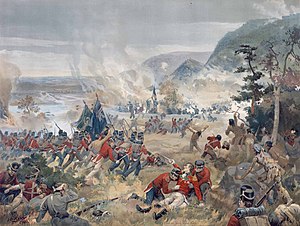Our website is made possible by displaying online advertisements to our visitors.
Please consider supporting us by disabling your ad blocker.
Battle of Queenston Heights
| Battle of Queenston Heights | |||||||
|---|---|---|---|---|---|---|---|
| Part of the War of 1812 | |||||||
 Death of General Brock at the Battle of Queenston Heights by John David Kelly | |||||||
| |||||||
| Belligerents | |||||||
|
|
| ||||||
| Commanders and leaders | |||||||
|
|
| ||||||
| Strength | |||||||
| 1,300 | 3,550[2] | ||||||
| Casualties and losses | |||||||
|
21 killed 85 wounded 22 captured[3] |
80–100 killed 80 wounded 955 captured, of whom 90 were wounded[4][5][6][7][8] | ||||||
The Battle of Queenston Heights was the first major battle of the War of 1812. A British victory, the battle occurred on 13 October 1812 near Queenston in Upper Canada (now Ontario).
United States regulars and New York militia led by Major General Stephen Van Rensselaer crossed the Niagara River and engaged British regulars and Canadian militia led by Major General Isaac Brock and Major General Roger Hale Sheaffe, who took command after Brock was killed. Mohawk warriors led by John Norton supported the British during the battle.
The battle was the result of an American attempt to establish a foothold on the Canadian side of the Niagara River before campaigning ended with the onset of winter. The decisive British victory was due to a poorly managed American offensive. Despite their numerical advantage and the widely dispersed British forces defending the Niagara frontier, the Americans were unable to get the bulk of their invasion force across the Niagara River due to British artillery and reluctance on the part of the undertrained and inexperienced American militia. As a result, British reinforcements arrived, defeated the unsupported American forces, and forced them to surrender. The battle has been considered historically significant due to the loss of the British commander.
- ^ Brian Jenkins (14 March 1996). Henry Goulburn, 1784–1856: A Political Biography. McGill-Queen's Press – MQUP. p. 76. ISBN 978-0-7735-1371-6.
- ^ Hitsman, p. 92
- ^ Malcomson, A Very Brilliant Affair, p. 297
- ^ Cruikshank, Documentary History, p. 143
- ^ Cruikshank, Documentary History, p. 92
- ^ Cruikshank, Documentary History, p. 121
- ^ Cruikshank, in Zaslow, p. 44
- ^ Cruikshank, Documentary History, p. 74
Previous Page Next Page
معركة مرتفعات كوينزتون Arabic کوئینستن هایتس دؤیوشو AZB Bitva na Queenston Heights Czech Schlacht bei Queenston Heights German Batalla de Queenston Heights Spanish نبرد کوئینستن هایتس FA Queenston Heightsin taistelu Finnish Bataille de Queenston Heights French クィーンストン・ハイツの戦い Japanese 퀸스턴 하이츠 전투 Korean


